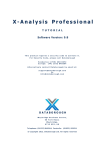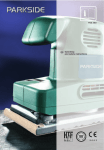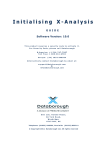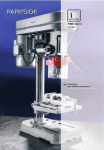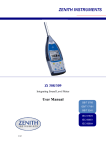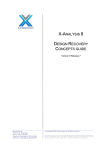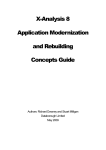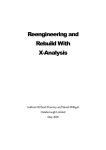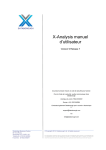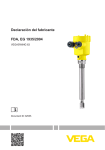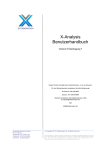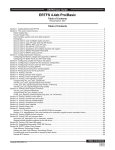Download Chapter 3: Analysis & Documentation
Transcript
X-ANALYSIS PROFESSIONAL T U T O R I A L Software Version: 10.0 This product requires a security code to activate it. For Security Code, please call Databorough N.America: +1 514-747-7007 Toll Free: 1 800-361-6782 Europe: (44) 1932 848564 Alternatively contact Databorough by email at: [email protected] Or [email protected] Unit 12b, Haland House, 66 York Road, Weybridge, KT13 9DY, UK Telephone: (01932) 848564, Facsimile: (01932) 85921 1 © Copyright 2013. Databorough Ltd. All rights reserved Table of Contents Table of Contents Welcome to this Tutorial .................................................................... 1 How this Tutorial is Organized? ........................................................................................................... 1 Who Should Read This Tutorial ........................................................................................................... 1 Acronyms Used in This Document ....................................................................................................... 2 Chapter 1: Introduction to X-Analysis .......................................... 3 Chapter 2: Getting Started with X-Analysis Client ..................... 5 Benefits of X-Analysis# ......................................................................................................................... 4 Prerequisites* ...................................................................................................................................... 4 Take the First Step – Select the X-Analysis Perspective ...................................................................... 6 Instructions to fill the Signon dialog .................................................................................................... 7 Application Library ............................................................................................................................... 8 Chapter 3: Analysis & Documentation ........................................ 10 Chronology of Features...................................................................................................................... 11 Work with Objects ............................................................................................................................. 11 Object Where Used ............................................................................................................................ 14 Export List to PDF, Microsoft Word, or Microsoft Excel ..................................................................... 15 Data Flow Diagram / DFD .................................................................................................................. 15 Variable Where Used ......................................................................................................................... 23 Structure Chart Diagram / SCD ......................................................................................................... 26 Detailed Structure Chart .................................................................................................................... 30 Hierarchal Structure Chart ................................................................................................................. 31 Document Manager............................................................................................................................ 36 Source Browser .................................................................................................................................. 49 Source Browser Toolbar..................................................................................................................... 51 Other Options on the Source Browser ............................................................................................... 58 Chapter 4: Data Modelling ............................................................ 67 Generating Data Model Diagram ....................................................................................................... 68 LFs/Access Paths................................................................................................................................ 72 File Field Details / FFD ....................................................................................................................... 73 Access Path Diagram / APD ............................................................................................................... 74 View Data........................................................................................................................................... 76 Chapter 5: Application Areas ........................................................ 79 Application Areas ............................................................................................................................... 80 Application Area Diagram .................................................................................................................. 81 Application Area Diagram Details ...................................................................................................... 82 Area Flow Diagram ............................................................................................................................ 83 Data Model Diagram – Application Area Specific ............................................................................... 84 Data Flow Diagram – Application Area Specific ................................................................................. 86 Chapter 6: Business Rules Analysis ............................................. 88 Business Rules ................................................................................................................................... 89 Business Rules Overlay ...................................................................................................................... 91 Consolidated Rules............................................................................................................................. 92 Chapter 7: Metrics Analysis .......................................................... 96 Audit Options ..................................................................................................................................... 97 Metrics Analysis.................................................................................................................................. 98 Metrics History ................................................................................................................................. 101 Screen Metrics ................................................................................................................................. 104 © Copyright Databorough Ltd. 2013 Page i Table of Contents File Metrics ....................................................................................................................................... 106 Business Process Logic Metrics ........................................................................................................ 107 Specialized Analysis ......................................................................................................................... 107 Problem Analysis .............................................................................................................................. 114 Object Allocation .............................................................................................................................. 115 Database Summary.......................................................................................................................... 116 Summary Report .............................................................................................................................. 116 Initialize Source Archiving ................................................................................................................ 119 Generate Metrics Analysis ................................................................................................................ 120 Generate Problem Analysis .............................................................................................................. 120 Chapter 8: What’s Next ............................................................... 121 Appendix A – Enabling the SEU Interface ................................... 122 Create User Profile XAN4SEU ........................................................................................................... 122 Press F10 and Page Down ............................................................................................................... 122 Appendix B – License Code Request Form.................................. 124 Appendix C – License Transfer Request Form............................ 125 © Copyright Databorough Ltd. 2013 Page ii Welcome to this Tutorial Welcome to this Tutorial This tutorial is a handy, stepwise, illustrative guide especially designed to familiarize you with the practical benefits of the X-Analysis product suite. How this Tutorial is Organized? The tutorial is divided into different chapters. Chapters 1 and 2 introduce you to the sophisticated X-Analysis software. Chapters 3 to 7 comprise comprehensive details of the X-Analysis solution sets. Chapter 8 offers a glance at what is more to come from X-Analysis. Chapter 1 Introduction Get a glimpse of the benefits of using X-Analysis. The chapter outlines the hardwarerelated prerequisites for installing the advanced software. Chapter 2 Getting Started With X-Analysis Client Provides you simple delineation of steps to starting the initialisation process for X-Analysis Chapter 3 Analysis and Documentation This chapter explains the latest computing and documenting features of X-Analysis. For better understanding of the features, the chapter uses specific screenshots of the respective windows and dropdown menus. Chapter 4 Data Modelling The chapter provides an in-depth, pictorial overview of how Data Modelling helps to understand the application design, in purview of all possible relationships among files. Chapter 5 Application Areas The chapter clarifies the necessity of sub-dividing an application into application areas. The chapter also throws light on the diagramming options available with application areas that help in the thorough detailing of the legacy application design. Chapter 6 Business Rules Analysis This chapter presents the two tools that make for easy and quick analysis of Business Rules. Chapter 7 Metrics Analysis This chapter brings to you advanced computing features and functions of the X-Audit module. Chapter 8 What’s Next Take a look at the exciting technological days ahead! Who Should Read This Tutorial Software professionals–from analysts and developers to architects and operations teams–who intend to analyse, document, or modernize AS/400 IBM i applications–will find this tutorial very useful. © Copyright Databorough Ltd. 2013 Page 1 Welcome to this Tutorial Explore this tutorial and gain insight into the inimitable facets of X-Analysis that equip users with rich understanding of existing legacy applications. Acronyms Used in This Document ACRONYM MEANING APD DFD DMD FFD SCD HSC Access Path Diagram Data Flow Diagram Data Model Diagram File Field Details Structure Chart Diagram Hierarchal Structure Chart © Copyright Databorough Ltd. 2013 Page 2 Chapter 1: Introduction to X-Analysis Chapter 1: Introduction to X-Analysis Get to know X-Analysis – the advanced and easy-to-use analysis tool. Learn about the tool‟s instant and automated features viz. impact analysis, crossreferencing, and graphical documentation of RPG and COBOL applications. Also, get updated on the hardware prerequisites needed for successful installation of the software. © Copyright Databorough Ltd. 2013 Page 3 Chapter 1: Introduction to X-Analysis Benefits of X-Analysis# Databorough's X-Analysis product suite is an essential tool for IBM i application documentation, design recovery, and re-engineering. The X-Analysis software works as a plugin under IBM's RDi / RDp / WDSC and Eclipse, enabling users to browse and visualize applications from a high-level model down to individual lines of code. This globally renowned tool is packed with features like RPG & COBOL as pseudo code, variable level impact analysis, graphical flow/structure charts, graphical data flowcharts, PDF/MS Word and MS Visio documentation wizards. X-Analysis allows technical analysts to navigate graphically through an IBM i application from a Windows PC. Working in a true client-server mode, X-Analysis automatically cross-references databases and ensures that the display is always up to date and a true representation of the application on the IBM i. Prerequisites* Before starting this tutorial, the following are required: » » The X-Analysis server and the Client components should be installed to an IBM i server and a Windows PC, respectively. The demo library – XAN4CDEM, and its cross-reference library – XAN4CDXA, should be successfully restored on the IBM i. # X-Analysis release 10.x onwards is digitally signed. *For details on how to implement these prerequisites, please refer to the X-Analysis User Manual. Note: This tutorial only teaches the usage of the tool and not topics like Initialisation, Reengineering, etc.* Note: Since the product is being continuously improved, you might notice some differences in the screens. © Copyright Databorough Ltd. 2013 Page 4 Chapter 2: Getting Started with X-Analysis Client Chapter 2: Getting Started with X-Analysis Client The chapter gives you the sequence of steps to get started with the software. There are simple guidelines that accompany individual screenshots, making the activation process easy to understand. The chapter contains: » Take the First Step – Select the X-Analysis Perspective » Instructions to fill the X-Analysis Signon dialog » Expanded Application Library © Copyright Databorough Ltd. 2013 Page 5 Chapter 2: Getting Started with X-Analysis Client Take the First Step – Select the X-Analysis Perspective Start IBM's RDi / RDp / WDSC/ or Eclipse 3.2 and above. Select Window > Open Perspective > Other > X-Analysis Open Perspective menu Select X-Analysis Perspective Click the OK button to start the X-Analysis Perspective. © Copyright Databorough Ltd. 2013 Page 6 Chapter 2: Getting Started with X-Analysis Client X-Analysis Perspective Expand New Connection node to bring up the Signon dialog. X-Analysis Signon dialog Instructions to fill the Signon dialog 1. Enter TCP/IP address / Computer Name of the IBM i to be accessed. 2. Enter username and password of a valid IBM i profile. 3. Check the „Use SSL‟ box for additional security. For details about the feature, refer to the XAnalysis User Manual. 4. Click the Login button. © Copyright Databorough Ltd. 2013 Page 7 Chapter 2: Getting Started with X-Analysis Client After a successful signon, X-Analysis Client displays a list of application libraries. These libraries are initialised using the master command X4WRKAPP on IBM i. Application Library When used for the first time the X-Analysis Client displays only one application library – XAN4CDXA. X-Analysis Client displaying Application Library Different nodes (options) are available under the cross-reference library node – XAN4CDXA. Expand the XAN4CDXA node to see the available options. © Copyright Databorough Ltd. 2013 Page 8 Chapter 2: Getting Started with X-Analysis Client Application Library expanded © Copyright Databorough Ltd. 2013 Page 9 Chapter 3: Analysis & Documentation Chapter 3: Analysis & Documentation Continual technical enhancements, syntax, variations in programming styles, financial and time constraints, absence of original application designers, and/or monolithic application codes are some reasons that necessitate changes in the existent application designs. System analysts or software professionals must be equipped with the technological knowhow for redesigning business applications. The X-Analysis toolset meets the requirements mentioned above. It is patterned to convert all IBM i applications into the latest format. This software suite has precise tools for conducting advanced application and documentation work. In this chapter, you will learn about the specialized Analysis & Documentation solution set. The features and options discussed here provide prompt and automated documenting and computing solutions. The chapter contains: » » » » » » » » » » » © Copyright Databorough Ltd. 2013 Chronology of features Work with Objects Object Where Used Export List to PDF/MS Word or MS Excel Data Flow Diagram Variable Where Used Structure Chart Diagram Detailed Structure Chart Hierarchal Structure Chart Document Manager Source Browser Page 10 Chapter 3: Analysis & Documentation Chronology of Features The Analysis & Documentation solution set is a sophisticated tool for instant and automated crossreferencing, impact analysis and graphical documentation of Synon/2E, RPG, and COBOL applications. All the functionality above (and more) is contained in the following separate features, explained in this tutorial: Work with Objects – It is a list of all the objects in a chosen application or application area. Object Where Used – It is a list of all usage references for an object. Export List to PDF/Microsoft Word or Microsoft Excel – The option to export data to MS Excel or a PDF/MS Word. Data Flow Diagram – It is an interactive, colour-coded bus routing block diagram for displaying an object relationship within an application. Variable Where Used – It is a list of all source lines from the source members, which have references to field/variable of a file or program. This includes lines from device files, and copybooks. Structure Chart Diagram – It is a graphic display for showing program-to-program relationships. Detailed Structure Chart Diagram – It is a graphic display for showing program-to-program relationships with files used by each program. It also displays each program‟s generated program text. Hierarchal Structure Chart Diagram – Colour-coded bus routing block diagram, which enhances the visual of program-to-program interrelationships. The user gets an exact idea of the hierarchal set-up of the programs. Document Manager – A utility that automatically generates structured system document in PDF / MS Word format. Source Browser – It is an interface for system analysis, reviewing, re-factoring, maintaining, and redeveloping in source code. Source Browser Toolbar – This toolbar contains a list of different options for viewing code within the Source Browser, such as Pseudo Code and Source View Level options etc. Other Source Browser Options – These are the other essential Source Browser options. Work with Objects Work with Objects displays a list of all the objects for a chosen application / application area. To generate the Object List for all files, double click on the Files node available under the application library. © Copyright Databorough Ltd. 2013 Page 11 Chapter 3: Analysis & Documentation X-Analysis displaying Files node The double click action invokes the Work with Objects dialog with „Type‟ set as *FILE and „Attribute‟ as PF. © Copyright Databorough Ltd. 2013 Page 12 Chapter 3: Analysis & Documentation Work with Objects dialog – Files Click the OK button to invoke the Object List window displaying all files. Object List window displaying all Files (PF) The Object List window is a multicolumn display. In this window, a user can sort a column data with a single click of a column heading. © Copyright Databorough Ltd. 2013 Page 13 Chapter 3: Analysis & Documentation Object Where Used The Object Where Used feature generates a list of all usage references for an object. To make an Object Where Used list for the object CUSF, locate and select the object CUSF from the Object List. Right click on CUSF and select the option Usage References from the submenu Object Where Used. This brings up the Object Where Used list for the Usage References of the object CUSF. Object Where Used The Object Where Used window is a multicolumn display. The Usage column displays uses of the object CUSF in a particular object. The Object Where Used window also allows a user to drill down to a specific line of code where the object is used. Scroll down to the object CUSTMNT1 in the Object Where Used window, displayed below. Object Where Used with CUSTMNT1 selected Double click on the row displaying CUSTMNT1. This retrieves the source member for the object CUSTMNT1 with the highlighted line referring to the object CUSF. © Copyright Databorough Ltd. 2013 Page 14 Chapter 3: Analysis & Documentation Drill down to an individual line for the Object Where Used Reference Export List to PDF, Microsoft Word, or Microsoft Excel X-Analysis provides a facility to export data from any displayed window. The window toolbar on the „Object Where Used‟ view has an Export Options dropdown button, with Export to PDF and Export to MS Excel as options. Select your desired option to export the list into PDF/MS Word or Excel. The user can set the export option as Export to MS Word using the X-Analysis Preferences. For the settings to take effect, the user must select/unselect the X-Ref. Export Options icon on Object Where Used Data Flow Diagram / DFD As the name suggests, a Data Flow Diagram or DFD is the diagrammatic representation of the data flow. A DFD depicts all the possible interrelationships among the files and programs contained within a particular application. A colour-coded DFD simultaneously plays the dual role of showing the data flow at high object level, besides providing contextual details regarding specific variables and parameters passed between objects. The DFD uses bus-routing layout, which offers the user two benefits. One, it gives the user a precise idea of where and how the data that is input affects the output desired; two, it enables the user to visualize how an object within an application correlates with the other objects. The diagrams showing the data flow in neat blocks help even a non-technical user get a clear idea of the object(s) interrelationships. For generating the DFD, the user has to return to the Object List using the navigation arrows available on the Eclipse toolbar. The user must select the object CUSF, and then choose the Data Flow Diagram option from the context menu as shown below: © Copyright Databorough Ltd. 2013 Page 15 Chapter 3: Analysis & Documentation Data Flow Diagram option This brings up the DFD for the object CUSF. Data Flow Diagram The DFD is also a graphic equivalent of the „Object Where Used‟ data. Besides the Logical Views/Access Paths for CUSF, a user can see how CUSF fits into the application (i.e. the programs that update CUSF, programs that use CUSF as an input file and so on). The dynamic and interactive diagram facilitates the user with access to other features contained within an object. There are varied and flexible features and options like Hide/Show Objects, Expand/Collapse Referenced Objects, View Annotation, Attributes – all of these and more are explained in the sections ahead. © Copyright Databorough Ltd. 2013 Page 16 Chapter 3: Analysis & Documentation Hide/Show Objects For having a better grasp of object interrelationships, a user may want to hide/show all objects pertaining to programs. A single click action on the icon alongside the objects enables the user to hide/show objects. In the following screenshot, the icon against Access Paths is clicked to hide objects. Hide Option for Objects The following screenshot shows how another click displays all the objects within. Show Option for Objects Expand/Collapse Referenced Objects The DFD takes another dynamic form when the user gets to expand the referenced object(s) on selecting a particular category from the main object‟s box. The following screenshot displays the action to be performed: © Copyright Databorough Ltd. 2013 Page 17 Chapter 3: Analysis & Documentation Expand Referenced Objects A single click on the arrow icon adjacent to Update Programs reveals all objects updating the file CUSF. The following screenshot displays the expanded view of the referenced objects‟ list: Expanded view of Update Programs View Annotation The View Annotation option allows the user to see annotation for a specific object. A red icon denoting Annotated text is present on the right side of the Object (see the following screenshot). © Copyright Databorough Ltd. 2013 Page 18 Chapter 3: Analysis & Documentation View Annotation option Double clicking on the View Annotation icon invokes the Annotation dialog box, displaying the notes that were written earlier. The user can further add/modify notes in the Annotation dialog box and click on the Save button. These notes will be viewable later using the same option. Annotation dialog Attributes The „Attributes‟ feature comprises impacted fields of a particular object. Through these fields, the main object is referenced. © Copyright Databorough Ltd. 2013 Page 19 Chapter 3: Analysis & Documentation Attributes icon The different objects corresponding to the main object have fields within them. The fields are known as „Attributes‟ and. these are easily accessible by clicking on the Attributes icon. The term „Attributes‟ changes to related attribute like Input, Update, Output etc. on expanding the Attributes button, as shown below: © Copyright Databorough Ltd. 2013 Page 20 Chapter 3: Analysis & Documentation Attributes Expanded Detail DFD icon The user can opt for the Detail DFD icon from the toolbar for viewing field usage of all the objects. Detail DFD icon When the user clicks on the Detail DFD icon, the „Attributes‟ section of all the objects gets expanded displaying referred fields from all objects. The following screenshot displays the detailed DFD screen: © Copyright Databorough Ltd. 2013 Page 21 Chapter 3: Analysis & Documentation Detailed DFD View Legend icon The Legend icon on the Eclipse toolbar displays the details of the colour scheme used by a DFD. Click on the Legend icon, as shown below: Legend icon The colour scheme helps a user understand the reference and association of specific objects. Legend Expanded © Copyright Databorough Ltd. 2013 Page 22 Chapter 3: Analysis & Documentation Variable Where Used This option is specifically useful for conducting impact analysis. It returns all source lines, where field/variable of a file or program is used and/or referenced, in any of the source members. The source members searched also include device files and copybooks. From the DFD for CUSF, search and select the object OE002. We can clearly see that the fields used by object CUSF are CUSNO and PRPCDE. Select CUSNO and opt for Variable Where Used from the context menu, as shown below: Variable Where Used option for CUSNO Select the All References option to invoke the Variable Where Used window for the field CUSNO. Variable Where Used view for CUSNO The window displayed above lists all references of field CUSNO from the entire application. The View Level menu icon is located on the X-Analysis toolbar, and the menu allows for six levels of Variable Where Used information. © Copyright Databorough Ltd. 2013 Page 23 Chapter 3: Analysis & Documentation View Level Menu The following image shows the expanded View Level menu of the Variable Where Used information: Expanded View Level Menu The Default View Level for ‘Variable Where Used’ X-Analysis Preferences (General preferences) window. option can be set using As an example, let us test the View Levels for the field CUSNO. Level 1: Level 1 lists all direct references to the CUSNO field. Variable Where Used – View Level 1 © Copyright Databorough Ltd. 2013 Page 24 Chapter 3: Analysis & Documentation Level 2: Level 2 adds extra indirect references, “one reference removed,” to the Level 1 list. For example, CUSTOMER is set equal to CUSNO (a direct reference) and then CUSTOMER is a variable in the statement “IF CUSTOMER = ZEROES” (a one reference removed indirect reference). Variable Where Used – View Level 2 © Copyright Databorough Ltd. 2013 Page 25 Chapter 3: Analysis & Documentation Level 3: Level 3 builds on the Level 2 references, adding indirect references that are “one further reference removed.” Level 4/Parameters: Level 4 further includes fields used as parameters. For example, in the statement “CALL LETN (&CUSNO &PREFIX &LETNR)”, CUSNO is a parameter to call LETN. Variable Where Used – View Level 4 Level 5/Cascading Parameters: Extending the information in Level 4, Level 5 includes references where CUSNO fields are parameters in a function, called by another function. Maximum Tracking: Tracks the usage of a variable or a field to its maximum level of indirection. This is the highest view level also referred as „Maximum Tracking‟. It displays Variable Where Used information for all the levels mentioned above, as well as any other possible references of the field CUSNO. The Variable Where Used option can be opted over a large variety of items including: Files, Array Definitions, Data Structures, Sub-Fields of a Data Structure, Indicators, Key Lists, Data Fields, File Formats, Subroutines, Program Variable, Array Elements, Parameter Lists, Parameters, Key Fields, Message Ids, EXCPT Names, etc. Structure Chart Diagram / SCD In order to interpret the application design it is important to have an idea about how the control transfers from one program to the next. The Structure Chart Diagram or SCD addresses this need by presenting a graphical diagram. It contains relevant information as per control flow and call structure. In addition, you can view data input objects and avail of a summarized description of each object. Important functional aspects like updates, prints, and displays are colour coded to help you quickly focus on these commonly preferred details. To create a Structure Chart Diagram, first select the object OE002 from the DFD for the object CUSF. © Copyright Databorough Ltd. 2013 Page 26 Chapter 3: Analysis & Documentation Double click on an object to bring up DFD for that object Double click on the object – OE002 to display its Data Flow Diagram. Data Flow Diagram for OE002 Select OEMENU and opt for the Structure Chart Diagram option from the context menu. Context menu on DFD Object © Copyright Databorough Ltd. 2013 Page 27 Chapter 3: Analysis & Documentation The Structure Chart Diagram is a nested tree diagram that displays the complete call hierarchy of the „programs called‟. Structure Chart Diagram SCD Legend The normal view of a Structure Chart Diagram is shown above. The Legend button available on the toolbar helps to interpret the different colours used in the Structure Chart Diagram. X-Analysis also allows annotation on the Structure Chart. Select an object displayed in the Structure Chart Diagram and opt for the Annotate option from the context menu. © Copyright Databorough Ltd. 2013 Page 28 Chapter 3: Analysis & Documentation Annotate option This brings up the Annotation dialog. Write your note and click the Save button. The annotation is stored in a file available in the cross-reference library. Annotation dialog for the object OEMENU Re-generate the Structure Chart Diagram to check for any object annotations. Annotation icon for OEMENU in re-generated Structure Chart Diagram (Double click on the Annotation icon to bring up the Annotation dialog). © Copyright Databorough Ltd. 2013 Page 29 Chapter 3: Analysis & Documentation Detailed Structure Chart The Detailed Structure Chart Diagram displays files used by each program, together with each program‟s generated program text. (X-Analysis recovers the generated program text, which describes the purpose of the listed programs, automatically.) To generate the Detailed Structure Chart Diagram, click the Show Narratives icon. Show Narratives icon on toolbar Detailed Structure Chart Diagram Click the Normal SCD icon on the toolbar to switch back to the Normal Structure Chart Diagram. © Copyright Databorough Ltd. 2013 Page 30 Chapter 3: Analysis & Documentation Hierarchal Structure Chart The Hierarchal Structure Chart is an upgrade on the Structure Chart Diagram. The Hierarchal Structure Chart offers a precise view of all the programs representing their control flow and call structure through neat, colour-coded bus routing block diagrams. Select the Hierarchal Structure Chart option from the context menu over OEMENU from the Structure Chart Diagram, as shown below: Hierarchal Structure Chart option The screenshot below shows the delineation of the main object OEMENU into several blocks of related objects in the order of calling. The colour codes indicate whether a particular object is command-based, or input-based, or print-based and so on. © Copyright Databorough Ltd. 2013 Page 31 Chapter 3: Analysis & Documentation Hierarchal Structure Chart Narration The user can avail of additional details regarding a specific object via the Narratives icon, as shown below: © Copyright Databorough Ltd. 2013 Page 32 Chapter 3: Analysis & Documentation Narration icon When the user clicks on this, a pop-up window provides the auto-generated narration for the program, as shown below: Narration dialog box © Copyright Databorough Ltd. 2013 Page 33 Chapter 3: Analysis & Documentation Referred Files The Hierarchal Structure Chart has a feature to display referred files inline. An expandable icon called Referred Files is available in each box as presented in the image below. Clicking on this icon displays list of files belonging to the object. The following screenshots show how Referred Files icon expands to display the files referred by object OE001. Referred Files icon The following screenshot shows the Referred Files of the object OE001. The colour-coded geometric shape before the file name indicates the file type. Referred Files – Expanded © Copyright Databorough Ltd. 2013 Page 34 Chapter 3: Analysis & Documentation Show Root Node By clicking on the Show Root Node icon, the root node gets displayed: Show Root Node icon Legend icon The Legend icon on the toolbar presents the colour scheme used by Hierarchal SCD. Click the Legend icon, as shown below: Legend icon The Legend helps the user to understand the reference and association of specific objects. Legend Expanded © Copyright Databorough Ltd. 2013 Page 35 Chapter 3: Analysis & Documentation Document Manager One of the most powerful functionalities of X-Analysis is its ability to generate structured documentation automatically. The inbuilt Document Manager facilitates the generation of PDF / MS Word document containing the system design information for specified objects. First, the Objects have to be marked for documentation. Select the option Mark for Documenter from the context menu over OEMENU. Mark an Object for Documentation X-Analysis provides the Mark all for Documenter option under the X-Analysis menu. This flags all objects displayed in the diagram. X-Analysis Menu The ‘Mark all for Documenter’ option is available for all diagrams and lists. Next, navigate back to the Object List window using the back arrow available on the Eclipse toolbar, and select the object CUSF. Select the Mark for Documenter option from the context menu on the object CUSF. © Copyright Databorough Ltd. 2013 Page 36 Chapter 3: Analysis & Documentation Mark for Documenter option – Context Menu on CUSF To start the documentation process, click the Documenter icon available on the toolbar. Documenter icon on toolbar This invokes the Document Manager dialog. © Copyright Databorough Ltd. 2013 Page 37 Chapter 3: Analysis & Documentation X-Analysis Document Manager The Document Manager dialog lists all the marked objects for documentation. Use the Move Up / Move Down / Delete / Delete All buttons to organise Objects/Members on the documenter list. The Invert Selection button on the Document Manager dialog unselects the selected objects and selects all the un-selected objects. After having organised the listed objects, click the Generate Document button. This invokes a Documenter Wizard. © Copyright Databorough Ltd. 2013 Page 38 Chapter 3: Analysis & Documentation System Documentation Wizard – Type and Location The Type and Location dialog consists of two sections: System Documentation type Document Details The System Documentation type section provides facilities to generate the following types of documents: Generate Single System Document: Generates a single PDF/MS Word document. Generate Individual System Documents: Generates a PDF/MS Word document for each object. Generate System Documents using previous values: Generates system documentation using the options selected in previous instance of system documentation. (This option is only available for generated system documents). Select the Generate Single System Document option. © Copyright Databorough Ltd. 2013 Page 39 Chapter 3: Analysis & Documentation The Document Details section specifies the document title, generated system document name, and its location. A user can specify a different file name for the generated PDF/MS Word document and a different location to save the generated document. Click the Next button. System Documentation Wizard – Specify Contents This System Documentation Wizard dialog allows a user to choose various features/attributes to be included in the system document. Select the features/attributes as shown above. Click the Next button. © Copyright Databorough Ltd. 2013 Page 40 Chapter 3: Analysis & Documentation System Documentation Wizard – Specify Sequence Confirm the sequence of the features / attributes selected for system documentation. Click the Next button. © Copyright Databorough Ltd. 2013 Page 41 Chapter 3: Analysis & Documentation System Documentation Wizard – Finish Select the required formatting options available to generate a system document. Click the Finish button to end configuring the system document contents and start generation of the document. After the system document generation is complete, the following dialog appears: © Copyright Databorough Ltd. 2013 Page 42 Chapter 3: Analysis & Documentation System Documentation Completion dialog Click the Yes button to open the generated document. A user can also view a previously generated document. To open a generated document, select the Open Application Folder option from the X-Analysis menu. Open Application Folder option This invokes the Application Folder containing the generated system documents. Double click on a generated document to open it. X-Analysis also creates a log file under ‘Application Folder’. It logs what the ‘Document Generator’ does in the process of documenting selected objects. Application Folder containing generated documents © Copyright Databorough Ltd. 2013 Page 43 Chapter 3: Analysis & Documentation System document – TOC © Copyright Databorough Ltd. 2013 Page 44 Chapter 3: Analysis & Documentation System document – Legends © Copyright Databorough Ltd. 2013 Page 45 Chapter 3: Analysis & Documentation System document – Selected Options System document – Object List © Copyright Databorough Ltd. 2013 Page 46 Chapter 3: Analysis & Documentation System document – Access Paths System Document – DFD Annotation © Copyright Databorough Ltd. 2013 Page 47 Chapter 3: Analysis & Documentation System Document – DFD System document – Index © Copyright Databorough Ltd. 2013 Page 48 Chapter 3: Analysis & Documentation Source Browser The process of system analysis, reviewing, re-factoring, maintaining, or redeveloping is incomplete without looking into the source code of the application. X-Analysis supports some very advanced features in its Source Browser. Get the Object List for all programs available in the application library. Double click on the Programs node present under the application library. Programs node This action invokes the Work with Objects dialog for object type „*PGM„. © Copyright Databorough Ltd. 2013 Page 49 Chapter 3: Analysis & Documentation Work with Objects dialog – Programs Click the OK button to generate the list of program objects. Object List for all Programs Double click the program CB906R from the Object List. This calls the Source Browser for the member CB906R. © Copyright Databorough Ltd. 2013 Page 50 Chapter 3: Analysis & Documentation Source Browser displaying CB906R source Source Browser Toolbar The Source Browser toolbar has the following options: Source Browser toolbar Source Options Source Outline Show Split Panel Pseudo Code Source level Diagram Options Generate UML Flowchart Screen Components Screen / Report Design Zoom in Lpex (available on WDSc/Rdi only) / SEU option (set XA preferences to select the appropriate option). More Info Export Options Print View Code © Copyright Databorough Ltd. 2013 Page 51 Chapter 3: Analysis & Documentation Source Options The Source Options menu allows a user to view source in various modes. The default source view is – Normal Source Code. Source Options Indented Source View Select Indented Source Code option from the Source Options menu. This displays the Indented Source Code view. Indented Source Code Return to Normal Source Code by selecting the Normal Source Code option. Source Outline The Source Outline feature displays an outline of the source member. The Source Outline view lists all subroutines available in the code. © Copyright Databorough Ltd. 2013 Page 52 Chapter 3: Analysis & Documentation Source Outline option Double click on any of the listed subroutines. This positions the cursor on the subroutine inside the source browser. Source Outline of CB906R Show Split Panel X-Analysis has an option to compare the Normal Source Code with its Business Process Logic code. This view helps the user to understand the Business Process Logic code better. The Show Split Panel icon is a toggle button, which invokes a split panel displaying the Normal Source and the Business Process Logic code, simultaneously. Show Split Panel option On selecting the Show Split Panel option, the following window is displayed: © Copyright Databorough Ltd. 2013 Page 53 Chapter 3: Analysis & Documentation Split Panel window – Normal Source Code and Business Process Logic Code Pseudo Code The Pseudo Code or Structured English view helps a non-technical user to understand the code better. Click the Pseudo Code icon. Pseudo Code option This brings up the Pseudo Code view. Pseudo Code The Pseudo Code icon has a behaviour toggle. Click it again to return to Normal Source Code. © Copyright Databorough Ltd. 2013 Page 54 Chapter 3: Analysis & Documentation Source Level The Source Level icon allows a user to view specific type of source lines by switching to different view levels for easy understanding of the code. By default, the source level is „5‟. Source Level Reduce the source level to View Level 1. This restricts the Source List to display comments and call operations only. Source Browser displaying Source at View Level 1 View Level 2 includes File Operations. View Level 3 includes Program Structure Operations. View Level 4 includes Field Operation. View Level 5 includes the Commented Out code & Exclude. Flowchart The other way to look at program source code is to check the execution model of that program, which is the Data Flowchart. Opt for the Flowchart option from the source browser. This generates Program Flowchart in MS Visio. © Copyright Databorough Ltd. 2013 Page 55 Chapter 3: Analysis & Documentation Flowchart option Flowchart in MS Visio Note that the Flowchart option creates an individual flowchart for each subroutine. The first page of the flowchart displays the processing for the Main Procedure. From the Main Procedure, a user can jump to any of the subroutines available in the program. © Copyright Databorough Ltd. 2013 Page 56 Chapter 3: Analysis & Documentation Jump option on the Flowchart From the context menu, click Jump to subroutine $PV0001 option to switch to the flowchart for the subroutine „$PV0001‟. © Copyright Databorough Ltd. 2013 Page 57 Chapter 3: Analysis & Documentation Subroutine Flowchart Other Options on the Source Browser To understand the other options available on the source browser, open the source browser for the program OE008. To call the source browser for OE008, go to the Object List. From the Object List, locate and select the program OE008. Bring up the context menu for the program OE008 and choose the Zoom Source option. Context menu on OE008 This brings up the source browser for the program OE008: © Copyright Databorough Ltd. 2013 Page 58 Chapter 3: Analysis & Documentation Source Browser for program OE008 Let us now discuss other important options available on the source browser. Member X-Reference On the source browser for the program OE008, select the line number 0022.00 with indicator „*IN03‟. From the context menu on „*IN03‟, select the Member X-Ref option. Member X-Ref option This displays the Member X-Ref view for the selected variable („*IN03‟). The Member X-Ref lists all source lines where the selected Field/Variable has been used / referenced. Member X-Ref © Copyright Databorough Ltd. 2013 Page 59 Chapter 3: Analysis & Documentation Jump to Subroutine One of the important features of the source browser is the ability to jump to a subroutine. Double click on one of the subroutines available in the source browser for the program OE008. Select Subroutine to perform jump action Double click on $RVCUS, which positions the cursor to the beginning of the subroutine – $RVCUS. Highlighted first line of the Subroutine Click the back navigation arrow to return to the line where the subroutine $RVCUS is called. Program Structure Chart This option provides another way of looking at the structure of the program. A Program Structure Chart graphically displays the sequence of calls in the program. Click the Program Structure Chart option available under the Diagram Options dropdown menu on the Source Browser toolbar. © Copyright Databorough Ltd. 2013 Page 60 Chapter 3: Analysis & Documentation Program Structure Chart option On selecting the Program Structure Chart option, a diagram appears displaying the Program Structure Chart for that program. Program Structure Chart for the program OE008 The Program Structure Chart shows each subroutine as small rectangles with grey background with the name of each subroutine. The object type i.e. the Function Type determines the colouring of all other shapes, Programs, Modules, and Service Programs. (Boxes, other than the subroutines, are the same size of a program element as used in the Structure Chart Diagram). On the Program Structure Chart, double click on a subroutine. This initiates the Source Browser for the program OE008 with the subroutine selected. © Copyright Databorough Ltd. 2013 Page 61 Chapter 3: Analysis & Documentation Program Structure Chart with Subroutine selected This displays the Source Browser for program OE008 with the subroutine „$RVCUS‟ selected. Source Browser for program OE008 Zoom Source to Files defined in File Specification The program OE008 has files defined in the File Specification: © Copyright Databorough Ltd. 2013 Page 62 Chapter 3: Analysis & Documentation Files listed on OE008 source A user can browse the source codes of associated files by double clicking on them. Alternatively, he can select CUSFL3 from the Source Browser and opt for the context menu. Then, select the Zoom Source option. Source Browser for the file CUSFL3 A user can also further drill down to the source code of associated PFILE (CUSF) of the LF, CUSFL3. PFILE selected on the Source Browser for CUSFL3 Double click on CUSF to invoke the Source Browser for the file CUSF. © Copyright Databorough Ltd. 2013 Page 63 Chapter 3: Analysis & Documentation Source Browser for the file CUSF X-Analysis makes the browsing of an application very easy. The Source Browser display helps the user to navigate and drill down to various related features, thus, supporting better understanding of the application. Let us now move on to some other features available on the source browser. Bring up the Source Browser for the program OE008. Screen/Report Design Most of the application programs interact either with display files or with printer files (DSPFs/PRTFs). The Source Browser provides a feature to view layout of the associated display/printer files. Note this feature does not require the execution of an actual program. Click the Screen/Report Design icon available on the Source Browser. Screen/Report Design option on the Source Browser This brings up the Screen Design window for the program OE008. © Copyright Databorough Ltd. 2013 Page 64 Chapter 3: Analysis & Documentation Screen Design option for the program OE008 Navigate back to the Source Browser for the program OE008 using the back navigation arrow. Zoom Source in SEU / Lpex Editor Lpex Editor A user can make changes to the source code using the Zoom in Lpex option. Click the Zoom in Lpex icon available on the Source Browser toolbar. Zoom in Lpex option on the Source Browser This invokes the Lpex editor from within the X-Analysis Perspective. SEU A user can make changes to the source code using the SEU option. Click the SEU icon available on the Source Browser toolbar. Invoke SEU option from the Source Browser © Copyright Databorough Ltd. 2013 Page 65 Chapter 3: Analysis & Documentation ‘Zoom in Lpex’ is a default option for all IBM Rational products having an RSE plugin. For all other eclipse products, SEU (5250 Emulator) is the default option. A user can change the default settings using the X-Analysis ‘General Preferences’ option. Creating an SEU (5250 Emulator) session requires the user XAN4SEU IBM i. Please refer to Appendix A for creating the user XAN4SEU. The X-Analysis Plugin comes with default preference settings. To change the preference settings, start IBM's RDi / RDp / WDSC/ or Eclipse 3.2 (and above), then select Window > Preferences to display the Preferences dialog. Preferences option To view / modify various X-Analysis Preferences, select the X-Analysis node. General X-Analysis Preferences Settings © Copyright Databorough Ltd. 2013 Page 66 Chapter 4: Data Modelling Chapter 4: Data Modelling Configuring the design of an application depends on an accurate data model. X-Analysis is fully loaded with the advanced capability of automatically extracting data model from an RPG/COBOL-based application. The data model derived through X-Analysis is viewable as an interactive diagram. The software extends the benefit of perusing the file-centric or application area specific filtering of the diagram. This chapter highlights the importance of understanding an application design and describes how the Data Modelling solution set helps in deciphering complicated codes of databases, thereby, making data maintenance and development work a less cumbersome process. The chapter contains: » » » » » © Copyright Databorough Ltd. 2013 Generating Data Model Diagram LFs/Access Paths File Field Details Access Path Diagram View Data Page 67 Chapter 4: Data Modelling The Data Modelling solution set is an add-on module dedicated to data model extraction. Prior to analyzing a legacy system, it is important for a user to understand the application design. An analyst looks for the Data Model information of the legacy system, which forms the foundation of the application design. In the context of X-Analysis, the term Data Model not only refers to the physical model of a database design but also refers to the foreign key or the relational model. X-Analysis automatically derives an explicit physical & logical data model by analyzing both the actual data and the programs that use that data, to verify the existence of any cross-file relationships. XAnalysis verifies these potential relationships by performing an integrity check to ensure that all data from dependant file validly refers to the data records from the owning file. A complete data model accurately describing all possible relationships among the files is essential for productive maintenance and development work. Such a model also provides a foundation to automate critical data administration tasks such as referential integrity testing and test data extraction. The graphical representation of automatically generated Data Model information in X-Analysis is a Data Model Diagram. The Data Model Diagram displays file relationships for an application or an application area. Generating Data Model Diagram Double click on the Data Model Diagram node under the cross-reference library, XAN4CDXA. Data Model Diagram option This will invoke the Data Model Diagram dialog as shown below: Data Model Diagram dialog © Copyright Databorough Ltd. 2013 Page 68 Chapter 4: Data Modelling It prompts a user to input the following: 1. Application Area Name (leave it as *NONE) 2. Object Name (leave it as *ALL) 3. DMD Data Options to re-use cached data or re-generate data (leave it as Re-generate DMD data) 4. Whether to display external relationships (available only when Data Model Diagram opted on Application Area) Then, click the OK button to generate Data Model Diagram for the entire application. Data Model Diagram for entire Application (XAN4CDXA) The Data Model Diagram displayed above consists of two halves. The upper half is the Data Model Diagram and the lower half is the DMD Details view. The Data Model Diagram displays a graphical representation of the derived data model information. The Data Model Diagram toolbar has a Legend icon. The different colours on the Legend dropdown convey the type of association represented by the coloured lines connecting various files. © Copyright Databorough Ltd. 2013 Page 69 Chapter 4: Data Modelling DMD Legend With the help of the DMD Legend, a user can easily understand the relations displayed on the Data Model Diagram. The DMD Details view displays the Files Connection Details. On the DMD Details view, the column „Relation Type‟ gives the relationship between the files in the „Dependent File‟ column and the files in the „Parent File‟ column. The „Dependent Fields‟ and the „Parent Fields‟ columns list the fields which relate to the „Dependent File‟ and the „Parent File„ respectively. The DMD Details list displays actual names of the listed Files and Fields. The DMD details list provides a toggle button, Show Description, to switch the DMD details list to display the description of the listed Files and Fields. DMD Details view with Show Description icon Click the Show Description icon to see descriptive names for all the files and the fields. DMD Details view with Description Click the Hide Description icon to switch back the DMD Details list to the actual names mode. © Copyright Databorough Ltd. 2013 Page 70 Chapter 4: Data Modelling DMD Details view with Hide Description icon Let us consider another aspect of the Data Model Diagram. A single click on an object displays the references of that object with the other objects in the Data Model Diagram. Click on the object CUSF to view its references. Data Model Diagram with the selected object CUSF The screen above displays relations for the file CUSF. This helps a user to make out all the relationships for the selected object. Another way of understanding file relations for any specific file is to have a file-specific Data Model Diagram. A file-specific Data Model Diagram displays the data model information for a given file only. Double click on CUSF to get the file-specific Data Model Diagram. © Copyright Databorough Ltd. 2013 Page 71 Chapter 4: Data Modelling File-specific Data Model Diagram for CUSF The Data Model Diagram displayed above is the file-specific Data Model Diagram for CUSF. It only has objects related to the file CUSF. Furthermore, the DMD Details list displays only those relationships related to the file CUSF. With the help of a file-specific Data Model Diagram, a user can view relations for any available files. These relations can be understood better, when we talk about them in the „View Data‟ section. LFs/Access Paths A user can opt for the LFs/Access Paths option for a file from the Data Model Diagram. The LFs/Access Paths option shows all access paths associated with a selected file. Select file CUSF, and then choose the LFs/Access Paths option from the context menu. © Copyright Databorough Ltd. 2013 Page 72 Chapter 4: Data Modelling LFs/Access Paths option on DMD This brings up the Access Paths list. LFs/Access Paths for the file CUSF File Field Details / FFD For wholesome understanding of the data model of an existing application, a user needs more details of a particular file. A particular file may consist of several fields. The File Field Details option helps the user here. By choosing the aforementioned option from the context menu the user gains easy access to particular field details of a selected file, CUSF. © Copyright Databorough Ltd. 2013 Page 73 Chapter 4: Data Modelling File Field Details option On clicking this option, a new window appears displaying File Field Details information. File Fields Details for the file CUSF Access Path Diagram / APD The Access Path Diagram is a graphical presentation of all the access paths related to a specific file. The user can generate the diagram by choosing the Access Path Diagram option from the context menu over a selected file, CUSF. © Copyright Databorough Ltd. 2013 Page 74 Chapter 4: Data Modelling Access Path Diagram option on DMD This brings up the Access Path Diagram for the file CUSF. Access Path Diagram for the file CUSF Go back to the Data Model Diagram displaying the file-specific Data Model Diagram for the object CUSF. © Copyright Databorough Ltd. 2013 Page 75 Chapter 4: Data Modelling View Data X-Analysis allows a user to view file records from the data model of an application. A user can view the actual records held in PFs using the View Data option. The View Data option is available on all objects displayed in the Data Model Diagram. View Data option on the DMD object Data View for the file CUSF Record Display The View Data window lists records for a selected file. Double click on a record to display the complete record. © Copyright Databorough Ltd. 2013 Page 76 Chapter 4: Data Modelling Double click on the record – Bertwhistle & Company Ltd. This brings up the record display along with its dependent files data. Record Display with Dependents The tab at the bottom displays dependent file data. These are any ACCESSES/OWNS/REFERS TO relationships for the file CUSF in the Data Model Diagram. On the record display, the Descriptors button displays the ACCESSED BY / REFERS TO relations. This is similar to a JOIN to a foreign file, to get the description for the code used from the Master/Owning file. Descriptors button on Record Display © Copyright Databorough Ltd. 2013 Page 77 Chapter 4: Data Modelling On clicking the Descriptors button, the following window is invoked: Window presenting Descriptors from Master/Owning file © Copyright Databorough Ltd. 2013 Page 78 Chapter 5: Application Areas Chapter 5: Application Areas X-Analysis is a diversified toolset, and true to its name and features, it helps in analyzing a monolithic legacy application by breaking it down into different application areas for the ease of working. X-Analysis lets its users further sub-divide the application areas, thereby, initiating thorough understanding of the legacy application. This chapter guides on how X-Analysis creates various application areas for easy comprehension and analysis of monolithic legacy applications. The chapter also presents the diagrammatic constructs related to the application areas that improve the user‟s understanding. The chapter contains: » » » » » © Copyright Databorough Ltd. 2013 Application Areas Application Area Diagram Area Flow Diagram: Application Area Specific Data Model Diagram: Application Area Specific Data Flow Diagram: Application Area Specific Page 79 Chapter 5: Application Areas Application Areas X-Analysis creates application areas, from part of one or multiple systems. Programmatically, it is possible to subdivide an application into logical modules or areas. This can be within the context of a single system or specific parts from multiple systems. For example, a user can have an application area as ORDERS, containing the Order Entry details from an Operational System to represent single system application areas. A user can also have an application area as ACCOUNTS, containing the Order Entry details from an Operational System and the Sales Ledger details from the Financial System, representing the application area as specific parts from multiple systems. The Application Areas facilitate grouping of an application into different business areas. X-Analysis creates application areas based on certain criteria called Application Area Rules. Hence, Application Area Rules become a useful mechanism to categorize an application into different application areas. A user can add a new application area by selecting the New Application Area option from the context menu in a cross-reference library or in an application area. New Application Area option The tutorial application contains pre-configured application areas. The following screenshot displays the available application areas in the tutorial application: © Copyright Databorough Ltd. 2013 Page 80 Chapter 5: Application Areas Application Areas under XAN4CDXA Application Area Diagram A user can easily sub-divide an application into business areas or application areas using X-Analysis. Similarly, a user can further split application areas into sub-application areas for better application analysis. X-Analysis provides another diagrammatic construct called the Application Area Diagram for enhancing the analysis of application areas. The Application Area Diagram helps in visualizing relationships between the application areas. When the option Application Area Diagram is opted for the entire cross-reference library, it displays all application areas and the sub-application areas (if available). The following screenshot displays the Application Area Diagram for the tutorial application. © Copyright Databorough Ltd. 2013 Page 81 Chapter 5: Application Areas Application Area Diagram for XAN4CDXA Each bluish grey box represents an application area. The box size is indicative of the number of objects it contains. A larger box has more objects as compared to a smaller box. The diagram also shows relationships among application areas displayed by selecting an application area. Select an application area to test this feature. The red and blue-coloured connecting arrows are the relationships among application areas. Blue Arrows – Indicate Program-to-Program calls. The blue arrow points towards the application area, which has more calling programs. Red Arrows – Indicate Program-to-File references. Application Area Diagram Details The Application Area Diagram also displays the relationship details for each application area. Click the Show AAD Details icon, available on toolbar to invoke the detailed view. Show AAD Details icon © Copyright Databorough Ltd. 2013 Page 82 Chapter 5: Application Areas Application Area Diagram details for XAN4CDXA Area Flow Diagram Another important diagrammatic construct is the Area Flow Diagram. This option is available for application areas only. It displays programs and files available in an application area along with their relations. Select the Area Flow Diagram option from the context menu of the application area, MVCPROCESS. Area Flow Diagram option © Copyright Databorough Ltd. 2013 Page 83 Chapter 5: Application Areas This invokes the Area Flow Diagram for the application area – MVCPROCESS. Area Flow Diagram for application area MVCPROCESS The default selection is on the file with the greatest number of programs referring to it. Data Model Diagram – Application Area Specific The Data Model Diagram for an application area represents relationships among the related objects that belong to that application area only. Select the Data Model Diagram option for the application area – MVCPROCESS. Data Model Diagram option from the Application Area Diagram © Copyright Databorough Ltd. 2013 Page 84 Chapter 5: Application Areas This invokes the Data Model Diagram dialog for the application area – MVCPROCESS. Data Model Diagram dialog Click the OK button to generate the Data Model Diagram for the selected application area. Data Model Diagram for an application area (Restricted) © Copyright Databorough Ltd. 2013 Page 85 Chapter 5: Application Areas The Data Model Diagram displayed above is a restricted Data Model and it only displays the objects which belong to the application area – MVCPROCESS. The toolbar on the Data Model Diagram has an option to generate the Un-restricted Data Model Diagram. Click the Unrestrict To Application Area icon. Unrestrict To Application Area icon Data Model Diagram for Application Area (Unrestricted) Note the objects displayed in blue are the ones which do not belong to the application area – MVCPROCESS. Data Flow Diagram – Application Area Specific The Data Flow Diagram for an application area displays objects that belong only to that application area. From the Data Model Diagram displayed above, right click on the object CUSTS and choose the Data Flow Diagram option. © Copyright Databorough Ltd. 2013 Page 86 Chapter 5: Application Areas Data Flow Diagram option from Data Model Diagram This generates the Data Flow Diagram for the object, CUSTS. Data Flow Diagram for CUSTS The objects highlighted in blue are those which do not belong to the application area MVCPROCESS, and are referred to as „External‟ objects. © Copyright Databorough Ltd. 2013 Page 87 Chapter 6: Business Rules Analysis Chapter 6: Business Rules Analysis Deriving business rules is the key to successful conversion of a legacy application into the latest format. The business rules are highly important because they provide critical information for any analyst, architect, or developer who is rebuilding a legacy application. X-Analysis offers two specific features that help the users access the business rules in quick time. This chapter discusses the features that expedite analysis of business rules. The chapter contains: » Business Rules » Business Rules Overlay » Consolidated Rules © Copyright Databorough Ltd. 2013 Page 88 Chapter 6: Business Rules Analysis Business Rules An application is chiefly characterized by the logic embedded in its source codes and process models. This logic is also collectively referred to as Business Rules. Legacy RPG and COBOL programs suffer from a drawback in which the business rules (logic) get mixed with screen handling, database I/O, and flow control. Retrieving these business rules is a time-consuming, highly specialized, expensive, and labour-intensive exercise. The task of decoding and configuring the legacy code becomes easier and more cost-effective by using X-Analysis. First, it automatically runs the scan on RPG & COBOL programs and 2E model. Secondly, it separates the rule code from the body of the application, and stores the business rule code into a neatly structured, usable repository. Finally, it provides precise text narratives describing these retrieved rules. The user can check out the derived business rules using the Business Rules view. Building a repository of business rules is a proactive step. It supports future reengineering/rewrite projects or package replacement projects and also facilitates ongoing legacy maintenance operations. The overall benefits of extracting business rules are: To help Business Analysts to understand and work with the system To communicate system functionality to users and management To help developers understand existing functionality, what it is and where it is located To improve system quality by facilitating consistency and accuracy To increase programmer productivity by enabling code reuse To feed the process of reengineering and migration To evaluate the suitability of packaged software being considered for purchase X-Analysis extracts the business rules with the help of a single option – Derive Business Rules. This option, which recovers the business rules, is available on the context menu of a crossreference library, an application area, and a *PGM type object of RPG/RPGLE/CBL attribute. In the tutorial application, there are some previously derived business rules. For viewing business rules, the user must double click on the Business Rules node under the tutorial application or a selected application area. The following screenshot shows the node under the tutorial application: Business Rules node under Tutorial Application This invokes the Business Rules window, displaying all the business rules for the tutorial application. © Copyright Databorough Ltd. 2013 Page 89 Chapter 6: Business Rules Analysis Business Rules window Scroll down to the object CUSTMNT1 and double click on Rule No. 00002. This zooms in to the business rules of the program CUSTMNT1 with the cursor positioned on the selected business rule. Business Rules for program CUSTMNT1 Similarly, the user can view the business rules from the source member display. For this, the user has to select the Business Rules option from the Source Options dropdown menu as shown in the screen underneath: © Copyright Databorough Ltd. 2013 Page 90 Chapter 6: Business Rules Analysis Source Code of CUSTMNT1 with Business Rules option On selecting the option, the user can immediately see the business logic within the context of the program as a whole. Business Rules Overlay The user can also observe the business rules embedded in the Normal Source Code by choosing the Business Rules Overlay option from the Source Options dropdown menu shown below: Business Rules Overlay option On selecting the option, the following window is invoked: © Copyright Databorough Ltd. 2013 Page 91 Chapter 6: Business Rules Analysis Business Rules Overlay window Consolidated Rules X-Analysis provides an important feature related to file-fields and their business rules. A user can view all the business rules related to a file-field combination. Select the Consolidated Rules node available under the cross-reference library. Consolidated Rules node under the Cross-Reference Library © Copyright Databorough Ltd. 2013 Page 92 Chapter 6: Business Rules Analysis Double click on Consolidated Rules to invoke the Work with Objects dialog. Work with Objects dialog to display Consolidated Rules Click the OK button to invoke a new window displaying the Consolidated Rules. Consolidated Rules for XAN4CDXA © Copyright Databorough Ltd. 2013 Page 93 Chapter 6: Business Rules Analysis Select a business rule listed under a file and expand the business rules node to see the actual business rules code. Expand Business Rules node to see the actual code The user has the choice to view the business rules of a particular function displayed in the Consolidated Rules window. For this, he must select a function and right click on it for the Zoom Source option, as shown below: Zoom Source option on the Consolidated Rules window Clicking the Zoom Source option will invoke the following window displaying all the business rules related to the selected file-field. © Copyright Databorough Ltd. 2013 Page 94 Chapter 6: Business Rules Analysis Window displaying all the Business Rules © Copyright Databorough Ltd. 2013 Page 95 Chapter 7: Metrics Analysis Chapter 7: Metrics Analysis The chapter presents another powerful option known as Metrics Analysis, which addresses the advanced computing requirements of today. The chapter contains: » » » » » » » » » » » » » © Copyright Databorough Ltd. 2013 Metrics Analysis Metrics History Screen Metrics File Metrics Business Process Logic Metrics Specialised Analysis Problem Analysis Object Allocation Database Summary Summary Report Initialize Source Archiving Generate Metrics Analysis Generate Problem Analysis Page 96 Chapter 7: Metrics Analysis The Metrics Analysis solution set comprises the X-Audit module. The module provides quality and complexity metrics for development and analytical purposes. The X-Analysis Client provides options related to the X-Audit module called Audit Options. Audit Options in X-Analysis Audit Options The Audit Options submenu is available on the context menu of application library and application areas. The following menu options are available under Audit Options: Metrics Analysis Screen Metrics File Metrics Business Process Logic Metrics Specialized Analysis Problem Analysis Object Allocation Database Summary Summary Report Initialize Source Archiving Generate Metrics Analysis Generate Problem Analysis © Copyright Databorough Ltd. 2013 Page 97 Chapter 7: Metrics Analysis Metrics Analysis “As a system evolves, its complexity increases, unless steps are taken to reduce it.” Professor Meir Lehman Metrics Analysis contains advanced computing solutions because X-Analysis understands the importance of monitoring, measuring, and managing the complexity and changes to databases of legacy applications. Metrics Analysis simplifies the procedure by classifying each program based on low, average, and high complexity. It uses mathematical formulae to ascertain the complexity level. The user has to assign weights in the range of 1 - 6 as per each file usage per program. If the sum total of weights is: >20 – it indicates High complexity 10-20 – it indicates Average complexity <10 – it indicates Low complexity Under the Metrics Analysis, we have other parameters as well like Halstead, Maintainability Index etc. Halstead – This is calculated using four different values (N1, N2, n1 and n2) obtained from the source code of each subroutine. These values show numbers of different op codes or number of different variables used in the subroutines, whether once or multiple times. Measurements are calculated thus: Module length = N1 + N2 Module vocabulary = n1 + n2 Halstead Volume = N *log(2)n Difficulty = (n1/2) * (N2/n2) Effort = Volume * Difficulty Maintainability Index – Hewlett-Packard engineers propound this formula. According to this, a number derived is directly proportional to the maintainability factor. This means the lower the number, the less maintainable the code will be and vice-versa. This calculation is also performed at the subroutine level. It uses four numbers as input: HV – Halstead volume from above CC – Cyclomatic Complexity from above LOC – Lines of actual code in the subroutine COM – Lines of non-blank comments in the subroutine (beginning after the previous ENDSR) MI = 5.2*naturallog (HV) – 0.23*CC – 16.2naturallog (LOC) + 50.0*sin (square root (2.46*COM)) The Metrics Analysis option provides low, medium, and high complexity classification of each program, based on the following attributes of a program: Source Type Source Lines Cyclomatic Complexity Halstead Maintainability Index Files Device files comprising Display Files and Printer Files Called Programs Calling Programs © Copyright Databorough Ltd. 2013 Page 98 Chapter 7: Metrics Analysis The Metrics information is broken down at the highest level into the following categories: Batch programs Interactive programs These two highest levels are then further sub-categorised as High, Average, and Low. The user-specified values determine where a program fits into these sub-categories. By default, these preferences are blank, so every program is „Low‟ complexity until the values have been set. Check the Metrics Preferences section (below) to set these values. Note: Please execute the Generate Metrics Analysis option before choosing the Metrics Analysis option. The following screen displays the Metrics information for the cross-reference library, XAN4CDXA. Metrics Analysis for XAN4CDXA The Metrics information displayed above has the following columns: 1. Complexity Level: For each attribute, e.g. each file usage = 1, etc. The sum total of these per program will be calculated and the Complexity level for the program worked out, e.g. Points <10 - LOW, 10-20 - AVERAGE, >20 - HIGH. If desired a user can allocate values for each complexity classification using the Metrics Preferences option. 2. Units: When collapsed, it displays total number of programs. When expanded, it displays name of program. 3. Source Type: Informs about the type of source. 4. Source Lines: It is total number of Source Lines in a source member. 5. Cyclomatic Complexity: Measures amount of decision logic in a program. Shows total number of conditional statements used. 6. Halstead: Displays program's complexity directly from source code based upon the operators and operands used. 7. Maintainability Index: The maintainability index calculated with certain formulae from linesof-code measures, Cyclomatic Complexity and Halstead complexity measures. 8. Files: It is total number of Files used by a source member. 9. Device Files: Total number of Display and Printer Files used by source member. 10. Called Programs: It display total number of called programs from a source member. 11. Calling Programs: It display total number of calling programs from a source member. © Copyright Databorough Ltd. 2013 Page 99 Chapter 7: Metrics Analysis Metrics Toolbar The Metrics toolbar comprises various options. Toolbar available on Metrics Analysis window Metrics Preferences A user can set the Metrics Preferences as per requirements. General Metrics Preferences icon on Metrics Analysis window toolbar Click the General Metrics Preferences icon to invoke the relevant dialog: General Metrics Preferences dialog Specify a high value, so that any value above this will determine that program is of higher complexity. Any program that falls below an average setting will be indicative of lower complexity. Print Metrics To print the Metrics information, click the Print button. Print icon on Metrics Analysis window toolbar Export Metrics Select PDF or MS Excel option as required, from the Export Options icon. Export Options on Metrics Analysis window toolbar © Copyright Databorough Ltd. 2013 Page 100 Chapter 7: Metrics Analysis Expand All Click the Expand All icon to expand all the data: Expand All option on Metrics Analysis toolbar Expanded Metrics Analysis window Metrics History The Metrics History displays all previous instances of the generated metrics data. The Metrics History data will be available only when the metrics data is generated more than once. The Metrics History can be generated for all the individual levels – High, Average & Low Totals for Batch / Interactive Programs and for the Grand Total. Double click on the Interactive Source Members row to generate the history. Invoking Metrics History for Interactive Programs Double click on the Low Total row to invoke the Metrics History window. © Copyright Databorough Ltd. 2013 Page 101 Chapter 7: Metrics Analysis Metrics History window for Interactive Programs Metrics History Chart X-Analysis can also display Metrics History in chart form for all the individual parameters. The Metrics History toolbar contains a dropdown button called Metrics Analysis. Metrics Analysis dropdown button The Metrics Analysis dropdown button contains a list of parameters against which a chart can be generated. Metrics Analysis dropdown Options Select Cyc. Complex. option from the dropdown menu: Cyclomatic Complexity Option for Chart This invokes the Metrics History chart displaying Cyclomatic Complexity: © Copyright Databorough Ltd. 2013 Page 102 Chapter 7: Metrics Analysis Metrics History Chart displaying Cyclomatic Complexity Similarly, a user can generate charts for all the other parameters. A user can check Metrics History for all the Interactive / Batch Programs and Grand Total from the Metrics window. Source code tracking The Metrics History also provides a facility to see changes in the source code. To invoke a Source Compare editor, expand one of the listed programs from the Metrics History list. Program selected for Source Code Comparison Double click on the selected program to invoke the Source Compare editor. © Copyright Databorough Ltd. 2013 Page 103 Chapter 7: Metrics Analysis Source Compare Editor displaying the Code Differences Screen Metrics There are various screen functions of a specific program. Screen Metrics is a display of these screen functions for a complete application and for all the application areas. Screen Metrics are designed to help re-facing projects and UI rewrites. They describe designs, uses and relationships of file complexities, thus, helping to measure the database complexities. The Complexity Level on Screen Metrics displays two groups i.e. the Grand Total and Application Area totals. Hereafter, all functions in application areas or cross-reference application are grouped on a dual level – complexity and type of function. The Screen Metrics option provides low, medium, and high complexity classification of the available screen functions. The Screen Metrics information is displayed for the complete application and its application areas. The Screen Metrics information displayed under the following headings: Grid type functions Record type functions Other functions The following screen displays the Screen Metrics information for the cross-reference library XAN4CDXA: Screen Metrics for cross-reference library XAN4CDXA © Copyright Databorough Ltd. 2013 Page 104 Chapter 7: Metrics Analysis The Metrics information displayed above has the following columns: 1. Complexity Level: This shows various groups. The topmost group is either Grand Total, or App area totals. All functions in application area or cross-reference application are then grouped based on complexity, and then on type of function 2. Units: Shows the number of functions in the group 3. Files: Total number of Files used by screen function 4. Database Fields: Total number of screen fields which are read from database fields 5. Work Fields: Total number of work fields in the group 6. Outgoing Calls: Number of functions called by this function 7. Incoming Calls: Number of functions calling this function 8. Function Keys: Total number of Function key-based actions called by functions in this group 9. Conditioning Fields: Number of fields on which there is a conditioning logic Screen Metrics Toolbar The Screen Metrics toolbar comprises various options discussed below. Toolbar available on Screen Metrics window Screen Metrics Settings Each user can set the Screen Metrics Settings as per his requirements. Screen Metrics Settings button on the Screen Metrics toolbar Click the Screen Metrics Settings icon to invoke the relevant dialog: Screen Metrics Preference Setting dialog The user can set the criteria for High / Average using the above dialog. Print Screen Metrics To print the Screen Metrics information, click the Print button available on the toolbar. © Copyright Databorough Ltd. 2013 Page 105 Chapter 7: Metrics Analysis Print icon on Metrics toolbar Export Screen Metrics Select the PDF or MS Excel option, as required under the Export Options icon. Export Options on Screen Metrics toolbar File Metrics The File Metrics is a display of metrics-related information on all the files. One can overview metrics data for the complete application and/or for all the application areas. The File Metrics displays information under the following headings: 1. 2. 3. 4. 5. 6. 7. 8. Units: Displays total number of Files Fields: Displays the total number of fields available in the file Access Paths: The total number of access paths for the file Creating Programs: The number of programs creating records in this file Reading Programs: The number of programs reading this file Updating Programs: The number of programs updating records in this file Deleting Programs: The number of programs deleting records from this file Total References: The total number of programs referencing this file (in effect total of 3 - 6) The following screen displays the File Metrics information for the cross-reference library, XAN4CDXA: Window displaying File Metrics for the cross-reference library XAN4CDXA © Copyright Databorough Ltd. 2013 Page 106 Chapter 7: Metrics Analysis Business Process Logic Metrics The Business Process Logic Metrics report displays the migrated logic data in metrics form - Total Lines, Excluded Lines, Controller Lines, and Process Logic. The following screen displays the Business Process Logic Audit Report for XAN4CDXA: Business Process Logic Audit Report for XAN4CDXA Specialized Analysis Measuring and managing the quality and complexity of a code base is the topmost priority for a systems analyst. Specialized Analysis is an invaluable feature that allows a user complete freedom to create customized reports using the full metrics database in the defined system repository. One can choose to view the report as a Static Report or a Difference Report. The latter plots changes in values over a period, thus giving a better idea of measurement. Opt for the Specialized Analysis option from the submenu Audit Options. The following screen displays the Specialized Analysis window: Specialized Analysis window for XAN4CDXA The user has an option to generate the pre-configured reports. Select any report from the listed category and opt for the context menu, as shown below: © Copyright Databorough Ltd. 2013 Page 107 Chapter 7: Metrics Analysis Context Menu on Report Definition Run Metrics Report When the user selects this option, the pre-configured report dialog invokes: Report Definition dialog © Copyright Databorough Ltd. 2013 Page 108 Chapter 7: Metrics Analysis Click the Submit Report button to generate the report. A batch job is submitted and on its completion, the Specialized Analysis window updates itself: Specialized Analysis window To view the generated report, click the report row and opt for the View Report option from the context menu. Updated Specialized Analysis window The report will be displayed as under: © Copyright Databorough Ltd. 2013 Page 109 Chapter 7: Metrics Analysis COMPLEX Report If required, the user can export this report to MS Excel. Modify Report Definition The user has the option to modify an existing Report Definition. Modify Report Definition option Select the Modify Report Definition option to invoke the report configuration dialog: © Copyright Databorough Ltd. 2013 Page 110 Chapter 7: Metrics Analysis Report Definition dialog After changing the report definition, click the Save Definition Only button. The user can click the Save and Submit Report button to generate a report. Copy Report Definition The user has the option to copy an existing Report Definition. On selecting this option, the user will retain an existing report besides the customised report. © Copyright Databorough Ltd. 2013 Page 111 Chapter 7: Metrics Analysis Copy Report Definition option Delete Report Definition If required, the user can delete an existing Report Definition. Delete Report Definition option Specialized Analysis Toolbar The Specialized Analysis toolbar comprises various options discussed below. Specialized Analysis toolbar © Copyright Databorough Ltd. 2013 Page 112 Chapter 7: Metrics Analysis Refresh Metrics The Refresh Metrics icon performs the refresh function. Refresh Metrics icon on Specialized Analysis toolbar Create New Report If required, the user can create a customised report. Use the Create New Report icon for this. Create New Report icon on Specialized Analysis toolbar The Create New Report icon invokes the report definition dialog. Create New Report dialog © Copyright Databorough Ltd. 2013 Page 113 Chapter 7: Metrics Analysis View Log The View Log icon shows the log related to the Metrics processing. View Log icon on Specialized Analysis toolbar Click the View Log icon to check the log. View Log window Problem Analysis The quality of analytical procedures improves if there is prior information of the existent inaccuracies in the data. Issues like object with no source and vice-versa, or source change after object creation date, or duplicate logical files can hamper advanced analyses. The Problem Analysis feature warns the user about any such discrepancies in the data. The feature has an expandable Problem Category section, which gives names of the individual files having a particular problem. To display the Problem Analysis data, select the Problem Analysis option from Audit Options under the context menu on XAN4CDXA. © Copyright Databorough Ltd. 2013 Page 114 Chapter 7: Metrics Analysis Problem Analysis for cross-reference library XAN4CDXA Expand the „Problem Category‟ section to view the objects having problem. Object Allocation The Object Allocation window displays the information about all the objects along with the application area names to which they belong. The following screen displays the Object Allocation window: Object Allocation for XAN4CDXA The above screen lists all objects from the application library XAN4CDXA and provides information about the application area. Note that some rows are blank under the application area column, which © Copyright Databorough Ltd. 2013 Page 115 Chapter 7: Metrics Analysis means that the object does not belong to any application area. Similarly note the „*‟ sign, which means that the object belongs to multiple application areas. Database Summary The Database Summary option gives the user access to the summarized database report for the entire cross-reference library. The report contains information related to files, their unique keys and other necessary file-related details. On clicking the option, the following window is displayed: Database Summary Report window Summary Report The Summary Report option generates structured report for the Metrics Analysis and the Problem Analysis as a PDF / MS Word document. Select the Summary Report option, available under the submenu, Audit Options from the context menu on XAN4CDXA. This invokes the following Documentation Wizard: Summary Report – Type and Location © Copyright Databorough Ltd. 2013 Page 116 Chapter 7: Metrics Analysis Specify the „Type and Location‟ information and click the Next button. Summary Report – Options Mark the options to be included in the Audit Report and click the Next button. Summary Report – Specify Sequence © Copyright Databorough Ltd. 2013 Page 117 Chapter 7: Metrics Analysis Specify the sequence of the contents for the Audit Report and click the Next button. Summary Report – Finish Choose the desired settings for the Audit Report and click the Finish button to end the report configuration and generate the report. When the report generation is over, the following dialog appears: X-Analysis dialog to open the generated report © Copyright Databorough Ltd. 2013 Page 118 Chapter 7: Metrics Analysis Initialize Source Archiving The Initialize Source Archiving option is available for the cross-reference library and the application areas. A user can run the option independently of metrics. On selecting this option, the following dialog is invoked: Initialize Source Archiving dialog Source archiving is started by command XACVINI, which sets up a controlling *DTAARA in the XA library and makes an initial copy of all source codes. If archiving is deactivated, and then restarted later, the initial archived copy is not made. Source archiving can be deactivated by XACVEND, which optionally clears all source archives and controlling data. This command can only be run on the server. Files All archived source versions are recorded in XAACVSRC, whose data is only ever purged when XACVEND DLTHISTO(*YES) is run (whereas metrics can be purged independently, which clears XMETOBJ). When archiving is active, the source date-time of the latest version archived is recorded in XAACVHDR. Archiving handles all the source types (whereas metrics only records for CL, RPG and CBL). Source archiving continues to maintain data in XMETOBJ/XMETOBJH, if necessary. The data in XMETOBJ/XMETOBJH is not necessary to the source archiving process itself, but is used by the PC client to locate the change history. If data is written to XMETOBJ by source archiving, the SRCACT field is set to the value 'A'. Processing Source archiving is invoked from XA4INIT, XREFRESH, XA4MAINT and XA4SRCMNT, which all call the wrapper program, XRACVMBR. The archive processing itself is done in *srvpgm XACV, in procedure XACV_ArchiveMember(). This procedure checks the source update date-time against the date-time recorded in XAACVHDR. If there is a difference, archiving takes place i.e. copy the source, write out to XAACVSRC, update XAACVHDR, and write out to XMETOBJ/XMETOBJH, if appropriate data is not already present in these files. © Copyright Databorough Ltd. 2013 Page 119 Chapter 7: Metrics Analysis The wrapper command/program XACVMBR/XRACVMBR first checks whether metrics is active, then performs either: a) if metrics are active, writes out a record to XMETCHGS, which will cause metrics processing to take place when XRMETCHGS is called, which is the case in XREFRESH, XA4INIT and XA4SRCMNT or b) if metrics are not active, calls procedure XACV_ArchiveMember(). If metrics is active, then the source archiving call is made from metrics processing, which will call XACV_ArchiveMember(). This is so that metrics will write the appropriate XMETOBJ/XMETOBJH records before source archive processing takes place. Purge A purge process (command XACVPRG) will move source to a user-specified library, and record the location in XAACVSRC. Purge is by cut-off date, as compared to the archive timestamp in XAACVSRC. The purge process always leaves one source version in place, even if the timestamp is older than the cut-off date. Generate Metrics Analysis The Generate Metrics Analysis option generates the Metrics data. The dialog shown below invokes, when a user opts for the Generate Metrics Analysis option: Generate Metrics Analysis dialog When the user clicks the OK button, related batch job initiates. Generate Problem Analysis The Generate Problem Analysis analyzes the application database files and reports problems. Select Generate Problem Analysis option, available under the submenu Audit Options from the context menu on XAN4CDXA. This invokes the following dialog: Generate Problem Analysis dialog Click the OK button to invoke the related batch job command. © Copyright Databorough Ltd. 2013 Page 120 Chapter 8: What’s Next Chapter 8: What’s Next Over two decades of dedicated research and development has rewarded us with a sophisticated software solution like X-Analysis. Built to meet the requirements of advanced computing and analysis, X-Analysis and its varied features make working of a legacy application easy to understand. We also experienced how X-Analysis helps in analyzing one big application as smaller logical business areas. Its enhanced Data Modelling feature not only exposes the Business Rules implicit in the data and the process models of an application, but also digs out the vast amount of business logic buried inside the source code of the programs. Today, we are at that exciting phase from where we can look forward to being more progressive and introduce futuristic Re-engineering or Rearchitecting tools and solutions. The X-Redo module is one such innovate. As we already know, X-Analysis dissects legacy application programs to decouple screens from embedded business logic. This componentization can be leveraged by the X-Redo module to generate JSFs, JavaBeans and ORM objects, thereby assisting in re-architecting a legacy application in J2EE. Having seen the X-Analysis solution set in action, you are now equipped to get on with the application redevelopment. © Copyright Databorough Ltd. 2013 Page 121 Appendix A – Enabling the SEU Interface Appendix A – Enabling the SEU Interface Create User Profile XAN4SEU When browsing source code using the AS400 SEU, it is necessary to be logged in as user XAN4SEU. The following gives instructions for creating the correct user profile. Step 1 Step 2 Login as QSECOFR. Create user profile XAN4SEU. Use the CRTUSRPRF command to create the user profile XAN4SEU. Make sure that the following parameters are set: User Password User Class Initial Program Library : : : : XAN4SEU *PGMR XSEUCLP XAOBJ Create User Profile (CRTUSRPRF) Type choices, press Enter. User profile . . . . . . User password . . . . . Set password to expired Status . . . . . . . . . User class . . . . . . . Assistance level . . . . Current library . . . . Initial program to call Library . . . . . . . Initial menu . . . . . . Library . . . . . . . Limit capabilities . . . Text 'description' . . . F3=Exit F4=Prompt F24=More keys . . . . . . . . . . . . . . . . . . . . . . . . . . . . . . . . . . . . . . . F5=Refresh . . . . . . . . . . . . . > XAN4SEU Name *USRPRF Name, *USRPRF, *NONE *NO *NO, *YES *ENABLED *ENABLED, *DISABLED > *PGMR *USER, *SYSOPR, *PGMR... *SYSVAL *SYSVAL, *BASIC, *INTERMED... *CRTDFT Name, *CRTDFT > XSEUCLP Name, *NONE > XAOBJ Name, *LIBL, *CURLIB MAIN Name, *SIGNOFF *LIBL Name, *LIBL, *CURLIB *NO *NO, *PARTIAL, *YES > 'X-Analysis – SEU User' F12=Cancel More... F13=How to use this display Press F10 and Page Down Set Special Authorities: *ALLOBJ *JOBCTL *SAVSYS © Copyright Databorough Ltd. 2013 Page 122 Appendix A – Enabling the SEU Interface Change User Profile (CHGUSRPRF) Type choices, press Enter. Additional Parameters Special authority . . . . . . . Special environment . . . . Display sign-on information Password expiration interval Limit device sessions . . . Keyboard buffering . . . . . Maximum allowed storage . . Highest schedule priority . Job description . . . . . . Library . . . . . . . . . Group profile . . . . . . . F3=Exit F4=Prompt F24=More keys . . . . . . . . . . . . . . . . . . . . F5=Refresh *ALLOBJ *JOBCTL *SAVSYS *SYSVAL *SYSVAL *SYSVAL *SYSVAL *SYSVAL *NOMAX 3 QDFTJOBD QGPL *NONE F12=Cancel *SAME, *USRCLS, *NONE... *SAME, *SYSVAL, *NONE, *S36 *SAME, *NO, *YES, *SYSVAL 1-366, *SAME, *SYSVAL, *NOMAX *SAME, *NO, *YES, *SYSVAL *SAME, *SYSVAL, *NO... Kilobytes, *NOMAX 0-9 Name Name, *LIBL, *CURLIB Name, *NONE More... F13=How to use this display Step 3 Logoff © Copyright Databorough Ltd. 2013 Page 123 Appendix B – License Code Request Form Appendix B – License Code Request Form License Code Request Form Kindly complete and confirm the details below and fax this form to: +44 1932 859211 Alternatively, this can be emailed to [email protected] Company Contact name Contact email Telephone Fax Address Post Code Country AS/400 Serial No. Model Processor Group (WRKLICINF) Purchase Order No. Agent or Distributor Comments If software is required to be sent and the AS/400 is not located at the same address as indicated above please provide the appropriate delivery address and contact details below. AS/400 Contact Contact email Telephone AS/400 Address Post Code Country Requested By Position Date _______________________________ Unit 12b, Haland House, 66 York Road, Weybridge, KT13 9DY, United Kingdom Tel: +44 (0) 1932 848564 Company Registration Number: 01795263 VAT number: 492 6942 05 © Copyright Databorough Ltd. 2013 Page 124 Appendix C – License Transfer Request Form Appendix C – License Transfer Request Form License Transfer Request Form Kindly complete and confirm the details below and fax this form to: +44 1932 859211 Alternatively, this can be emailed to [email protected] Company Contact name Contact email Telephone Fax Address County Post Code Country Current System i Serial No. Processor Group (WRKLICINF) Feature Code Please indicate the details of the new machine below. New System i Serial No. Processor Group (WRKLICINF) New Feature Code Purchase Order No. A minimum administration fee of £1,500 is charged for any license transfer. An additional fee may be charged on the basis of the upgrade of the original processor band. Declaration: I/We hereby confirm that with effect of __________ (MM/DD/YY) the license purchased for system __________ will be transferred to system__________ and subsequently completely removed from the old system. Requested and confirmed by Position Date _______________________________ Unit 12b, Haland House, 66 York Road, Weybridge, KT13 9DY, United Kingdom Tel: +44 (0) 1932 848564 Company Registration Number: 01795263 VAT number: 492 6942 05 © Copyright Databorough Ltd. 2013 Page 125
































































































































